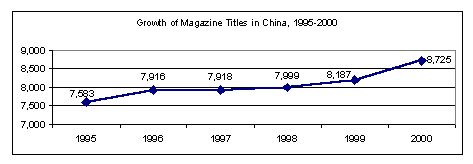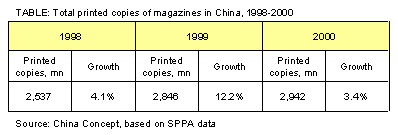Current
Market
The Chinese government strictly controls the
number of magazines published in China.
There has been a steady increase in the number
of magazines from 1995 to 2000, while the same
period has seen a steady decrease in the number
of newspapers in China, reflecting a slight
softening of the government's tight control
over the number of magazines.

The State Press & Publication Administration
(SPPA) classifies magazines published in China
into seven categories: general interest, social
science, science & technology, culture &
education, art & literature, children and
pictorial.
Magazines of general interest and social science
are the only two categories that have seen growth
in both magazine numbers and their percentage
of total magazine titales over the period of
1998 to 2000. This trend reflects increasing
market demand for magazines of the two categories
over the last several years in China.

As displayed above, the ever-increasing printed
copies of magazines demonstrate that the China
magazine market has been growing in the last
several years. Of the seven categories,
the categories of general interest, science
& technology, children and pictorial have
seen growth in their circulation.
With the growing China magazine market, competition
is becoming more intense. While both numbers
of magazines and circulation are increasing,
the market is more fragmented with the fact
that average copies per issue for one magazine
were much smaller in 2000 than the previous
year. The general interest category has
seen the most significant increase in competition.
It is also noted that the number of monthly
magazines as a percentage of the total has been
increasing during the 1998-2000 period, while
the perccentage of both bimonthly and quarterly
magazines has become smaller over the same timeframe.
Still, the absolute numbers of bimonthly and
quarterly magazines have been on the upturn.
Two Business Models
By profit structures, magazines in China may
be classified into two groups:
- Magazines making most revenues from large
circulation
- Magazines making most revenues from ad sales
Magazines adopting the first business model
target low-income readers, while those adopting
the second model achieve their revenues mainly
by advertising and targeting higher-income readers
like managers and well-educated and wealthy
women.

It is seen from the table above that in 1999,
revenues from magazines advertising accounted
for 8.7% of the total magazine revenues.
In 2000, the same percentage grew to 9.3%, indicating
China's magazine market is shifting to the ad
sale-driven model. With China's large
population of rural people whose incomes are
relatively low, however, magazines whose costs
are low and rely heavily on magazine sales will
have a large market share for a long time.
Foreign Involvement
To date, Hearst Corp., Hachette Filipachi and
other foreign companies are all involved with
Chinese-language magazine titles, and there
are estimated to be more than 100 magazines
now produced in China with foreign involvement.
These examples cover a range of collaborative
agreements that include:
- Foreign partner provides all or part of
the copyright, and has no other involvement
- Foreign partner provides the copyright and
is involved in publishing
According to a China Concept Consulting survey,
magazines with foreign involvement are more
satisfied with their performance in China than
magazines without foreign involvement.
Measured on the dimensions of management, editorial,
content resources, marketing and promotion,
ad sales, distribution, talent retention, government
relations and financing, a comparison of their
performance is profiled below:

|







